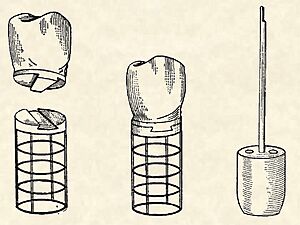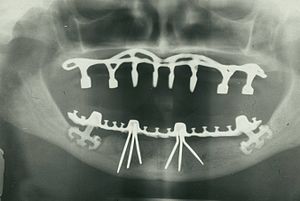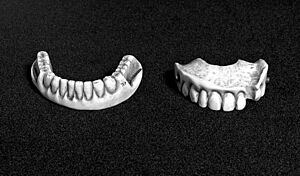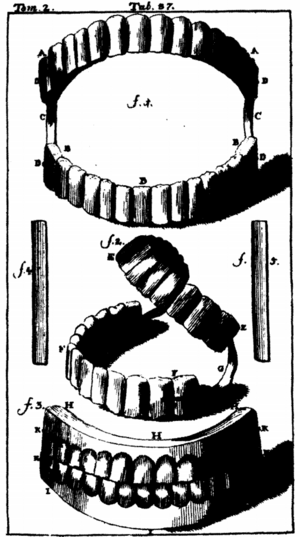History of dental treatments facts for kids
The history of dental treatments goes back thousands of years! This article will look at how people fixed their teeth up until 1981.
The oldest known example of someone fixing a cavity was found in a Stone Age person. This was about 14,000 years ago. The first known use of a filling after removing a decayed tooth part was also found in a Stone Age person in Italy. This was around 13,000 years ago. Some researchers even think that early dental work might have happened 130,000 years ago with Neanderthals!
A big step forward in implants was when bone grew directly onto a metal implant. This process is called osseointegration. The word was first used in 1981 by a scientist named Tomas Albrektsson.
Contents
Dental Implants: New Teeth for Old
People have tried to replace missing teeth for thousands of years. We know this from old discoveries! In ancient China, about 4,000 years ago, people used carved bamboo pegs. They tapped these into the jawbone to replace lost teeth. In ancient Egypt, about 2,000 years ago, similar pegs were made from valuable metals.
Some Egyptian mummies even had transplanted human teeth. Others had teeth made from ivory. In 1931, in Honduras, scientists found the jawbone of a young Mayan woman. She lived around 600 AD. Three of her missing front teeth were replaced with pieces of sea shells. These shells were shaped like teeth. Bone had grown around two of these shell implants. This shows they were used for chewing, not just for looks! This jawbone is now in a museum at Harvard University.
In more recent times, in 1969, someone tried an implant that looked like a tooth. But it was surrounded by soft tissue, not bone.
Early Modern Implants
In the early 1900s, many different types of implants were tried. One of the first successful ones was the Greenfield implant system from 1913. This implant was made of a special metal called iridioplatinum. It was attached to a gold crown. This implant actually showed bone growing onto it and lasted for several years.
The first time titanium was used for implants was in 1940. Researchers noticed how closely bone grew to titanium screws. It was very hard to remove them! These researchers were the first to describe what would later be called osseointegration.
In 1951, Gottlieb Leventhal put titanium rods into rabbits. His good results made him believe titanium was the best metal for surgery.
The Discovery of Osseointegration
In the 1950s, scientists in England were studying blood flow. They made small titanium chambers to put into the ears of rabbits. In 1952, a Swedish bone surgeon named Per-Ingvar Brånemark was studying how bones heal. He used these titanium chambers in rabbit leg bones.
After his study, he tried to take the expensive chambers out of the rabbits. But he couldn't! Brånemark saw that the bone had grown so close to the titanium that it was stuck. He did more studies on animals and humans. All his studies showed that titanium had this special ability.
In the 1950s, Leonard Linkow was one of the first to put titanium and other metal implants into jawbones. Then, artificial teeth were attached to these metal pieces. In 1965, Brånemark placed his first titanium dental implant into a person. He started working on teeth because it was easier to watch the implants. Also, many people had missing teeth, so there were many people to study. He called the way bone stuck to titanium osseointegration.
Since then, implants have mostly become three main types:
- Root form implants: These are the most common type. They look like a tooth root. There are about 18 different kinds, all made of titanium. They have different shapes and surfaces. Some evidence suggests smoother implants might have fewer problems.
- Zygoma implants: These are long implants that can attach to the cheek bone. They go through the upper jaw sinus. They are used when there isn't enough bone in the upper jaw for regular implants.
- Small diameter implants: These are thin implants. They are sometimes used to hold dentures in place or for braces.
Ceramic implants, made from a material called alumina, were used in the 1960s and 1970s. But they had problems and were stopped in the 1990s. They were replaced by implants made from zirconia.
In the 2000s, robot-assisted dental surgery was also developed. This includes using robots for dental implants.
Dentures: False Teeth Through Time
As early as the 7th century BC, the Etruscans in Italy made partial dentures. They used human or animal teeth held together with gold bands. The Romans probably learned this technique by the 5th century BC.
Wooden Dentures from Japan
Wooden full dentures were invented in Japan around the early 1500s. First, soft bees wax was put into the patient's mouth to make a mold. Then, harder bees wax was used to fill the mold. Wooden dentures were then carefully carved based on this model.
The first wooden dentures were completely made of wood. Later ones used real human teeth or carved materials like pagodite, ivory, or animal horn for the teeth. These dentures had a wide base. This helped them stay in place using a natural sticking effect. This was a very advanced technique for that time! It wasn't copied in the Western world until the late 1700s. Wooden dentures were still used in Japan until the 1800s.
In 1579, gold and silver dentures were made for the French King Charles IX. In 1728, Pierre Fauchard described how to make dentures. He used a metal frame and teeth carved from animal bone. The first porcelain dentures were made around 1770 by Alexis Duchâteau.
In 1791, the first British patent for artificial teeth was given to Nicholas Dubois De Chemant. He had worked with Duchateau. He sold his porcelain teeth starting in 1792. Most of his porcelain came from Wedgwood.
In the 1600s, Peter de la Roche in London was one of the first "operators for the teeth." These were people who said they specialized in dental work. They were often goldsmiths, ivory carvers, or students of barber-surgeons.
Modern Denture Materials
In 1820, Samuel Stockton, a goldsmith, started making high-quality porcelain dentures. These were set on 18-carat gold plates. Later dentures, from the 1850s, were made of Vulcanite. This is a type of hardened rubber where porcelain teeth were placed. In the 1900s, acrylic resin and other plastics were used.
In Britain, studies showed that in 1968, 79% of people aged 65–74 had no natural teeth. By 1998, this number had dropped to 36%.
Famous Denture Wearers
George Washington (1732–1799) had tooth problems his whole life. He lost his first adult tooth at age 22. He only had one tooth left when he became president! Some people thought he lost them from cracking nuts. But historians now think a medicine he took for illnesses like smallpox might have caused it.
He had several sets of false teeth made. Four of them were made by a dentist named John Greenwood. Contrary to a popular story, none of his dentures were made of wood. The set he wore as president was carved from hippopotamus and elephant ivory. They were held together with gold springs. Before these, he had a set made with real human teeth. He likely bought these teeth from enslaved people in 1784. Washington's tooth problems caused him constant pain. This pain might be seen in many of his portraits, including the one on the $1 bill.
Charles Darwin (1809-1882) also had tooth problems from a young age. This was because he often vomited due to his lifelong illness and seasickness. Repeated vomiting can cause tooth damage from stomach acid. In 1836, he visited a dentist in Australia. Earlier, in 1833, he wrote that he needed a denture repaired. Later in life, in 1852, he had five back teeth removed. This was done using chloroform, a type of anesthetic. This is one of the first times chloroform was recorded being used in dentistry.
3D Printing: A New Era in Dentistry
What is 3D Printing? Over the last 50 years, 3D printing and imaging have greatly changed dentistry. These new technologies include Stereolithography and Digital Light Processing.
Stereolithography (SLA) The Stereolithography (SLA) method was invented by Charles Hull in 1986. This technology was first made for factories. But it has been used in many different areas, including dentistry. In dentistry, SLA is used for things like making models, temporary fake teeth, retainers, aligners, and models for braces.
How SLA Works
An ultraviolet (UV) laser is used to harden a liquid plastic resin layer by layer. This liquid resin is in a container. The laser hardens each layer of resin. This process is repeated until the product is finished. The final product is then made stronger in a UV oven or a special liquid bath.
Digital Light Processing (DLP) Digital Light Processing (DLP) was created shortly after SLA in 1987. SLA and DLP are very similar. But DLP has a few key differences in how it works. This technology is used for custom dental molds and models. It also makes custom-fit medical equipment.
How DLP Works
DLP uses 3D printing machines that can read special computer files. The process starts with a platform being lowered into a container of liquid resin. A digital light source then hardens each layer. The light hardens the resin, and layers build on top of each other. Finally, the finished item is removed from the printer. The resin used is a type that hardens when exposed to light. DLP printers are fast because they harden an entire layer at once.
Dental Uses for 3D Printing
Scientists have even 3D printed "toothbuds" that look like real teeth! Other uses include:
- Making dental models
- Creating digital models for braces
- Making medical models
- Creating guides for drilling and cutting during surgery
- Making parts for dentures
See also
 In Spanish: Historia de la odontología para niños
In Spanish: Historia de la odontología para niños






